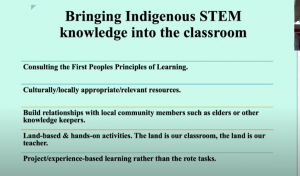I got this idea from Shirley about looking into stories of Indigenous scientists and I found this amazing talk by Dr.Leroy Little Bear, a scientist, an academic, a researcher, a professor, and a member of the Blood Tribe of the Blackfoot Confederacy. He has maintained a lifelong professional interest in the philosophy of science, especially theoretical physics, from a First Nations perspective.
I also came across these articles discussing different aspects of Indigenous knowledge and education:
- Researchers from Native American and Indigenous communities explain how colleagues and institutions can help them to battle marginalization.
- Meet the scientists embracing traditional Indigenous knowledge
Some of the topics included in the articles are:
- How to raise your voice to insist on Indigenous equity in STEM
- How to establish equitable and respectful collaborations
- How to recognize that communities maintain data sovereignty
- Asking for consent from Indigenous communities
I highly suggest watching Dr.Leroy Little Bear’s talk. It’s very inspirational!




